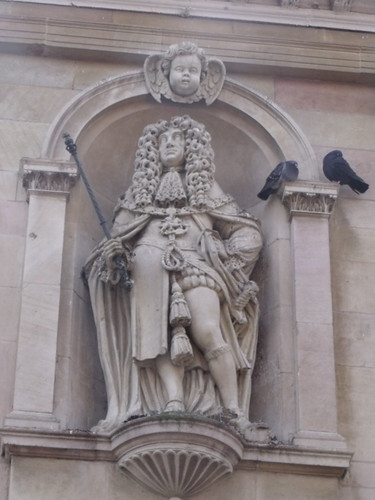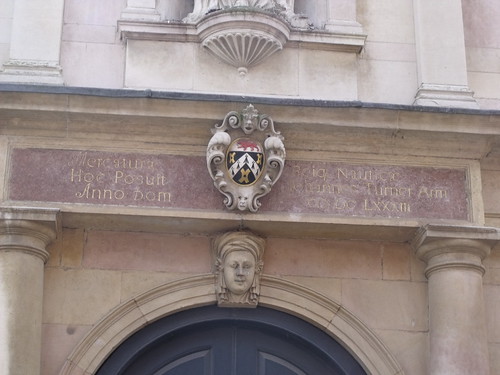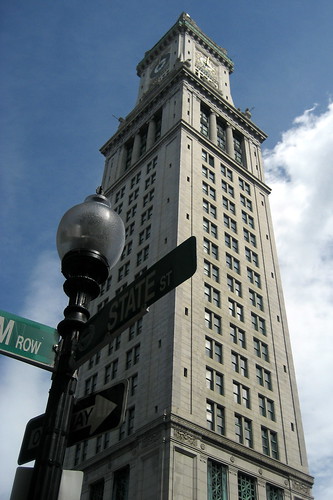Custom House, Purfleet Quay, King's Lynn - Statue of Charles II
Image by ell brown
This area of King's Lynn Old Town is the Purfleet Quay, near the River Great Ouse.
This is the Grade I listed Custom House in King's Lynn.
A statue on the Custom House of King Charles II.
Custom House. 1683 by Henry Bell. Built for Sir John Turner MP
as a merchants' exchange. First floor let to the Collector of
Customs, entire building bought by Customs 1718 and used as
customs house until 1989. Alterations either in 1718 or 1741
during repairs following gale damage: ground floor was
partitioned and the present staircase probably inserted 1718,
panelling and decoration of upper floors probably 1741.
Stone with plaintile roof below lead flat.
Designed to 4:5 proportions. 5 bays to north and south
elevations, 4 to east and west, originally in form of open
arcade, the first floor supported on 4 Roman Doric entactic
columns on tall polygonal plinths. Bell's engraving of the
building seems to show the west arcade closed shortly after
construction, or never open.
Elevations are broadly similar. Arcade bays separated by Roman
Doric pilasters supporting a plain Doric entablature below the
first-floor 2-light cross casements with leaded glazing.
Corner bays have 2 blind recessed panels to ground floor,
vertically placed, and a single-light transomed casement to
the first floor. Arcades have keystones in form of nautical
heads.
First-floor windows separated by Ionic pilasters. Acanthus
modillion eaves cornice below hipped roof with flat.
North and south roof slopes with 2 pedimented dormers
separated by a segmental-headed dormer, east and west slopes
with only 2 pedimented dormers, all with 2-light casements.
Cornice balustrade removed 1741. Timber lantern of Greek cross
plan composed of 4 arches each carrying a pediment. All of the
internal and external angles of the continuous entablature
below these pediments have a Corinthian leaf. Above is an
hexagonal lantern with an ogee cap which replaces the obelisk
and statue of Fame blown down in 1741. The lead flat has a
heavy turned balustrade with square corner piers. The eastern
2 piers disguised chimney flues. Variations between
elevations.
North front has a broken-forward central bay with a heavy
panelled door. Entablature above with a cartouche and
inscription: Mercaturx Reicp Nauticx Hoc posuit Johannes
Turner Anno dom CDDCLXXXIII Arm (sic). Above is a niche with a
statue of Charles II on a fluted semi-circular pedestal
flanked by a pair of Corinthian pilasters (sculptor unknown).
Shallow pediment over this bay. East side arcades are simply
filled in. South side arcades also filled in except the centre
bay which has a door beneath a fanlight. West arcade bays
filled with iron windows with a top-hung casement to centres:
glazed with small panes. 1718.
INTERIOR. Barrel-vaulted cellars. Ground floor originally open
with 4 bridging beams running north-south and one running
east-west at the junctions of which were 4 columns described
above. The western 2 columns survive, one encased in the C18
partitioning. The others were removed (the central one would
have blocked an intended doorway, the other, to the east,
would pierce the staircase). The partitioning is partly
masonry and sufficiently substantial to support the upper
floors.
Closed string staircase with bolection panelling, turned
balusters and a heavy handrail supported on square newels.
Numerous minor choppings and compromises were required to
insert staircase. Of original stairs nothing is known.
First floor west room (the Long Room) originally 2 rooms.
Large-framed panelling probably 1741. On east wall are 2 fire
surrounds with bolection mouldings. North-east room with
smaller-framed fielded panelling which may be 1718. Roof
structure of principals with butt purlins. Cupola supported on
4 cross-braced trusses.
PURFLEET QUAY. Probably a loading point of the Purfleet from
C13. Lime and stone quay existed in 1547. Present brick
structure with limestone dressings is result of continuous
repair and rebuilding, the earliest identifiable elements
being C17. Included portion begins at south-east corner of
Custom House and runs 60 metres west along north bank of Fleet
only. English bond brickwork. Stone steps laid into ashlar
well drop from quay to bed of fleet. Top of quay with granite
paving.
This was the first classical building in King's Lynn, owing to
precursor of the London Royal Exchange of 1670-1 by Edward
Jerman and to Pieter Post's Stadhuis, Maastricht, Holland.
Custom House, King's Lynn - Heritage Gateway
Custom House, Purfleet Quay, King's Lynn - Entablature
Image by ell brown
This area of King's Lynn Old Town is the Purfleet Quay, near the River Great Ouse.
This is the Grade I listed Custom House in King's Lynn.
This is the Entablature above the door from the north side. With the inscription
Custom House. 1683 by Henry Bell. Built for Sir John Turner MP
as a merchants' exchange. First floor let to the Collector of
Customs, entire building bought by Customs 1718 and used as
customs house until 1989. Alterations either in 1718 or 1741
during repairs following gale damage: ground floor was
partitioned and the present staircase probably inserted 1718,
panelling and decoration of upper floors probably 1741.
Stone with plaintile roof below lead flat.
Designed to 4:5 proportions. 5 bays to north and south
elevations, 4 to east and west, originally in form of open
arcade, the first floor supported on 4 Roman Doric entactic
columns on tall polygonal plinths. Bell's engraving of the
building seems to show the west arcade closed shortly after
construction, or never open.
Elevations are broadly similar. Arcade bays separated by Roman
Doric pilasters supporting a plain Doric entablature below the
first-floor 2-light cross casements with leaded glazing.
Corner bays have 2 blind recessed panels to ground floor,
vertically placed, and a single-light transomed casement to
the first floor. Arcades have keystones in form of nautical
heads.
First-floor windows separated by Ionic pilasters. Acanthus
modillion eaves cornice below hipped roof with flat.
North and south roof slopes with 2 pedimented dormers
separated by a segmental-headed dormer, east and west slopes
with only 2 pedimented dormers, all with 2-light casements.
Cornice balustrade removed 1741. Timber lantern of Greek cross
plan composed of 4 arches each carrying a pediment. All of the
internal and external angles of the continuous entablature
below these pediments have a Corinthian leaf. Above is an
hexagonal lantern with an ogee cap which replaces the obelisk
and statue of Fame blown down in 1741. The lead flat has a
heavy turned balustrade with square corner piers. The eastern
2 piers disguised chimney flues. Variations between
elevations.
North front has a broken-forward central bay with a heavy
panelled door. Entablature above with a cartouche and
inscription: Mercaturx Reicp Nauticx Hoc posuit Johannes
Turner Anno dom CDDCLXXXIII Arm (sic). Above is a niche with a
statue of Charles II on a fluted semi-circular pedestal
flanked by a pair of Corinthian pilasters (sculptor unknown).
Shallow pediment over this bay. East side arcades are simply
filled in. South side arcades also filled in except the centre
bay which has a door beneath a fanlight. West arcade bays
filled with iron windows with a top-hung casement to centres:
glazed with small panes. 1718.
INTERIOR. Barrel-vaulted cellars. Ground floor originally open
with 4 bridging beams running north-south and one running
east-west at the junctions of which were 4 columns described
above. The western 2 columns survive, one encased in the C18
partitioning. The others were removed (the central one would
have blocked an intended doorway, the other, to the east,
would pierce the staircase). The partitioning is partly
masonry and sufficiently substantial to support the upper
floors.
Closed string staircase with bolection panelling, turned
balusters and a heavy handrail supported on square newels.
Numerous minor choppings and compromises were required to
insert staircase. Of original stairs nothing is known.
First floor west room (the Long Room) originally 2 rooms.
Large-framed panelling probably 1741. On east wall are 2 fire
surrounds with bolection mouldings. North-east room with
smaller-framed fielded panelling which may be 1718. Roof
structure of principals with butt purlins. Cupola supported on
4 cross-braced trusses.
PURFLEET QUAY. Probably a loading point of the Purfleet from
C13. Lime and stone quay existed in 1547. Present brick
structure with limestone dressings is result of continuous
repair and rebuilding, the earliest identifiable elements
being C17. Included portion begins at south-east corner of
Custom House and runs 60 metres west along north bank of Fleet
only. English bond brickwork. Stone steps laid into ashlar
well drop from quay to bed of fleet. Top of quay with granite
paving.
This was the first classical building in King's Lynn, owing to
precursor of the London Royal Exchange of 1670-1 by Edward
Jerman and to Pieter Post's Stadhuis, Maastricht, Holland.
Custom House, King's Lynn - Heritage Gateway
Boston: Custom House
Image by wallyg
Boston's first skyscraper, the sixteen floor Customs House, was completed in 1849, with a twenty-six floor tower added in 1915. It was Boston's tallest building for 49 years, surpassed in 1964 by the Prudential Building. Initially built at the end of the city docks (the area has since enroached on the waterfront) to facilitate cargo inspectation and the collection of maritime duties, it was rennovated in the 1990's and is now a timeshare owned by Marriott Vacations.
The original neoclassical design, by Ammi Burnham Young, was that a cruciform Greek Revival structure, combining a Greek Doric portico with a Roman domed rotunda. It has 36 fluted Doric columns, each carved from a single piece of Quincy granite, and weighing 42 tons--only half of which actually support the structure. The The entire structure sits on filled land and is supported by 3,000 wooden piles driven through fill to bedrock.
By 1905, increased shipping necessitated expansion and in 1913 the firm Peabody and Stearns was hired to add a tower to the base. Since the Custom House was federally owned, it was exempt from Boston's 125-foot height restriction, allowing the steel-framed Italian Renaissance tower to rise 496 feet (151m). The 22 clock on the upper tower, which at 22 feet in diameter was the largest clock in the world at the time, has since become a city icon.
After custom officials moved to the Thomas P. O'Neill building in 1986, the city of Boston purchased the Custom House and it remained unoccupied for 14 years. In 1995, Marriott Ownership Resorts and The Beal Companies announced plans to develop it into timeshare resort hotel, with Jung Brann Brannen Associates retained as architects. Limited usable square footage on each of the tower floors necessitated creative design that resulted in 87 one-bedroom suites with 26 different floorplan designs. Other additions included lobby and rotunda exhibit space, that features rotating selection of exhibits from the Peabody Essex Museum; and a refurbished indoor/outdoor observation deck on the 26th floor.
Custom House Historic District #73000321 (1973)
No comments:
Post a Comment